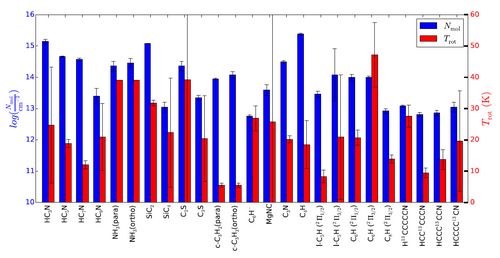IRC +10216 is the prototypical carbon star exhibiting an extended molecular circumstellar envelope. Its spectral properties are therefore the template for an entire class of objects. So far, the 1.3 cm wavelength (e.g. radio "K" band) is still not explored in an unbiased view. Therefore, we carried out a spectral line survey with the Effelsberg-100 m telescope toward IRC +10216 to study its 1.3 cm spectral line characteristics. In the circumstellar shell of IRC +10216, we find 78 spectral lines, among which 12 remain unidentified (Overview of the 1.3 cm line survey is displayed in Fig. 1.). The identified lines are assigned to 18 different molecules and radicals. A total of 23 lines from species known to exist in this envelope are detected for the first time outside the solar system and there are additional 20 lines first detected in IRC +10216. The potential orgin of "U" lines is also discussed. Assuming local thermodynamic equilibrium (LTE), we then determine rotational temperatures and column densities of 17 detected molecules. Molecular abundances relative to H2 are also estimated. A non-LTE analysis of NH3 shows that the bulk of its emission arises from the inner envelope with a kinetic temperature of 70 ± 20 K. Evidence for NH3 emitting gas with higher kinetic temperature is also obtained, and potential abundance differences between various 13C-bearing isotopologues of HC5N are evaluated. Overall, the isotopic 12C/13C ratio is estimated to be 49 ± 9. Finally, a comparison of detected molecules in the 1.3 cm wavelength with the dark cloud TMC-1 indicates that silicate-bearing molecules are more predominant in IRC +10216. This work by Yan Gong, Christian Henkel, Silvia Spezzano, Sven Thorwirth, Karl M. Menten, Friedrich Wyrowski, Ruiqing Mao, and Bernd Klein has been published in the Astronomy and Astrophysics. The detailed information can be found in http://adsabs.harvard.edu/abs/2015A%26A.574A.56G 
By with GONG Yan Fig 1. Comparison of the column densities and rotational temperatures of different molecules. The labels for column densities are blue on the left side, while those for rotational temperatures are red on the right side. Here, a Trot of 39.1 K has been taken for para and ortho NH3 (see Sect. 4.1 and Table 4).
|




